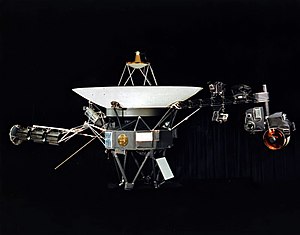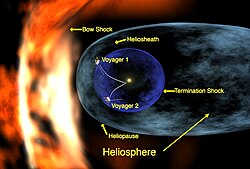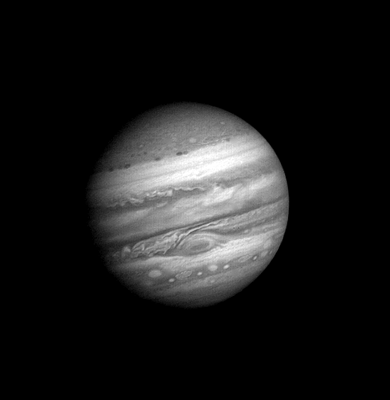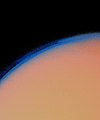Voyager 1
From Wikipedia, the free encyclopedia
 Voyager spacecraft |
|
| Organization | NASA |
|---|---|
| Mission type | Flyby |
| Flyby of | Jupiter & Saturn |
| Launch date | September 5, 1977 (11539 days ago) |
| Launch vehicle | Titan IIIE/Centaur |
| Mission duration | undefined |
| Home page | NASA Voyager website |
| Mass | 721.9 kg (1,592 lb) |
| Power | 420 W |
The Voyager 1 spacecraft is a 722-kilogram (~1,600lb) robotic space probe of the outer Solar System and beyond, launched September 5, 1977. It remains operational, currently pursuing its extended mission to locate and study the boundaries of the Solar System, including the Kuiper belt and beyond. Its original mission was to visit Jupiter and Saturn; and it was the first probe to provide detailed images of the moons of these planets.
Voyager 1 is currently the farthest human-made object from Earth, traveling away from both the Earth and the Sun at a speed that corresponds to a greater specific energy than any other probe.[1] Though its twin space-probe, Voyager 2, was launched 16 days earlier, Voyager 2 will never pass Voyager 1. Neither will the New Horizons mission to Pluto, despite being launched from Earth at a faster speed than both Voyager craft, since during its flight Voyager 1 benefited from a number of gravity assisted speed boosts. The current speed of New Horizons is greater than Voyager 1 but when New Horizons reaches the same distance from the sun as Voyager is now, its speed will be about 13 km/s compared to Voyager's 17 km/s.[2]
As of February 1, 2009, Voyager 1 is about 108.60 AU (16.247 billion km, or 10.095 billion miles) from the Sun, and has passed the termination shock, entering the heliosheath, with the current goal of reaching and studying the heliopause, which is the known boundary of our stellar system. If Voyager 1 is still functioning when it finally completes the passage through the heliopause (effectively becoming the first human-made object to leave our star system), scientists will get their first direct measurements of the conditions in the interstellar medium, which may provide clues relevant to the origin and overall nature of the Universe. At this distance, signals from Voyager 1 take more than fourteen hours to reach its control center at the Jet Propulsion Laboratory, a joint project of NASA and Caltech in La Cañada Flintridge, California. Voyager 1 is on a hyperbolic trajectory and has achieved escape velocity, meaning that its orbit will not return to the inner solar system. Along with Pioneer 10, Pioneer 11, Voyager 2, and the New Horizons, Voyager 1 is an interstellar probe.
Voyager 1 had as its primary targets the planets Jupiter and Saturn and their associated moons and rings; its current mission is the detection of the heliopause and particle measurements of solar wind and the interstellar medium. Both of the Voyager probes have far outlasted their originally-planned lifespan. Each probe gets its electrical power from three radioisotope thermoelectric generators (RTGs), which are expected to continue to generate enough electric power to let the probes keep communicating with Earth at least until the year 2025.
Contents |
[edit] Mission profile
Voyager 1 was originally planned as Mariner 11 of the Mariner program. From the outset, it was designed to take advantage of the then-new technique of gravity assist. Luckily, the development of interplanetary probes coincided with an alignment of the planets called the Grand Tour. The Grand Tour was a linked series of gravity assists that, with only the minimal fuel needed for course corrections, would enable a single probe to visit all four of the solar system's gas giant planets: Jupiter, Saturn, Uranus, and Neptune. The identical Voyager 1 and Voyager 2 probes were designed with the possibility of a Grand Tour in mind, and their launches were timed to enable the Grand Tour if things went well. However, the two Voyagers were only funded by Congress as Jupiter-Saturn probes. At one time, the program was called the "Mariner Jupiter-Saturn" project.
Because of this planetary alignment, Voyager could visit each of these planets in just twelve years, instead of the thirty years that would usually be required.
Voyager 1 was launched on September 5, 1977, by the National Aeronautics and Space Administration from Cape Canaveral, Florida aboard a Titan IIIE/Centaur carrier rocket, shortly after its twin space probe, Voyager 2 on August 20, 1977. Despite being launched after Voyager 2, Voyager 1 was sent on a faster trajectory so it reached Jupiter and Saturn before its twin space probe did.
For details on the Voyager instrument packages, see the separate article on the Voyager program.
[edit] Jupiter
Voyager 1 began photographing Jupiter in January 1979. Its closest approach to Jupiter was on March 5, 1979, at a distance of 349,000 kilometers (217,000 miles) from its center. Due to the greater resolution allowed by close approach, most observations of the moons, rings, magnetic fields, and radiation environment of the Jupiter system were made in the 48-hour period bracketing closest approach. It finished photographing the planet in April.
The two Voyager spacecraft made a number of important discoveries about Jupiter and its satellites. The most surprising was the existence of volcanic activity on Io, which had not been observed from the ground or by Pioneer 10 or 11.
|
The Great Red Spot as seen from Voyager 1. |
|||
[edit] Saturn
The gravity assist at Jupiter was successful, and the spacecraft went on to visit Saturn. Voyager 1's Saturn flyby occurred in November 1980, with the closest approach on November 12, 1980 when it came within 124,000 kilometers (77,000 mi) of the planet's cloud-tops. The craft detected complex structures in Saturn's rings, and studied the atmospheres of Saturn and Titan. Because of the earlier discovery of a thick atmosphere on Titan, the Voyager controllers at the Jet Propulsion Laboratory elected for Voyager 1 to make a close approach of Titan and terminate its Grand Tour. (For the continuation of the Grand Tour, see the Uranus and Neptune sections of the Voyager 2 article.) The Titan-approach trajectory caused an additional gravitional deflection that took Voyager 1 out of the plane of the ecliptic, thus ending its planetary science mission. Voyager 1 could have been given an altered trajectory, whereupon the slingshot effect of Saturn's gravity would have propelled the spacecraft to a rendezvous with Pluto, but this option was not exercised, because the different trajectory would have prohibited the close fly-by of Titan, which was a higher scientific priority at the time.[3]
[edit] Interstellar mission
On February 14, 1990, Voyager 1 took the first ever "family portrait" of our solar system as seen from outside. [4] It is estimated that both Voyager crafts have sufficient electrical power to operate their radio transmitters until at least after 2025, which will be over 48 years after launch.[5] Voyager 1 is the most distant functioning space probe to receive commands and transmit information to Earth.
| Year | End of specific capabilities as a result of the available electrical power limitations |
|---|---|
| 2007 | Termination of plasma subsystem (PLS) |
| 2008 | Power off Planetary Radio Astronomy Experiment (PRA) |
| 2010 | Terminate scan platform and Ultraviolet spectrometer (UVS) observations |
| 2015 | Termination of Data Tape Recorder (DTR) operations (limited by ability to capture 1.4 kbit/s data using a 70 m/34 m antenna array. This is the minimum rate at which the DTS can read-out data.) |
| 2016 approx | Termination of gyroscopic operations |
| 2020 | Start shutdown of science instruments (as of 2008-03-18 the order is undecided but the Low-Energy Charged Particles, Cosmic Ray Subsystem, Magnetometer, and Plasma Wave Subsystem instruments are expected to still be operating) |
| 2025 or after | Can no longer power any single instrument. |
[edit] Heliopause

As Voyager 1 heads for interstellar space, its instruments continue to study the solar system; Jet Propulsion Laboratory scientists are using the plasma wave experiments aboard Voyager 1 and 2 to look for the heliopause.
Scientists at the Johns Hopkins University Applied Physics Laboratory believe that Voyager 1 entered the termination shock in February 2003.[6] Some other scientists have expressed doubt, discussed in the journal Nature of November 6, 2003.[7] In a scientific session at the American Geophysical Union meeting in New Orleans on the morning of May 25, 2005, Dr. Ed Stone presented evidence that Voyager 1 crossed the termination shock in December 2004. The issue will not be resolved until other data becomes available, since Voyager 1's solar-wind detector ceased functioning in 1990. However, in May 2005 a NASA press release said that consensus was that Voyager 1 was now in the heliosheath.[8] Scientists believe the craft will reach the heliopause in 2015.
[edit] Golden record
Included in the spacecraft is one of the two Voyager Golden Records. This phonograph record contains sounds and images selected to portray the diversity of life and culture on Earth. It is intended for any intelligent extraterrestrial life form, or for future humans, that may find it.
[edit] Current status
As of November 28, 2008, Voyager 1 was at a distance of 108.27 AU (approximately 16.2 terameters or 0.0017 light years) from the Sun, which makes it the most distant human-made object from Earth.[9] At this distance, it is more distant from the Sun than any known natural solar system object, including Eris and 90377 Sedna, but excluding long-period comets. (Although Sedna has an orbit that takes it 975 AU away from the Sun at aphelion, as of 2006 it is less than 90 AU away from the Sun and approaching its perihelion at 76 AU. [10][11])
At the above distance, light or radio waves, which travel at 299,792.5 kilometers per second (63,241 AU/year or 670,616,629 miles per hour), take over 14.6 hours to reach the Earth from Voyager 1. As a basis for comparison, the Moon is about 1.4 light-seconds from Earth, the sun is approximately 8.5 light-minutes away, Pluto is about 5.5 light-hours, and the nearest star is 4.3 light-years away. As of May 2008, Voyager 1 was traveling at a speed of 17.1 kilometers per second relative to the sun (3.6 AU per year or 38,400 miles per hour or 61 600 km/h), 10% faster than Voyager 2. On November 19, 2015, Voyager 1 will be 133.15 AU from the Sun. Accurate information concerning its location can be found in this NASA paper with heliocentric coordinates of both probes extrapolated up to 2015.
Voyager 1 is not heading towards any particular star, but in about 40,000 years it will be within 1.6 light years of the star AC+79 3888 in the Camelopardalis constellation.[12]
On March 31, 2006, the amateur radio operators from AMSAT in Germany tracked and received radio waves from Voyager 1 using the 20-meter (66 ft) dish at Bochum with a long integration technique. Its data were checked and verified against data from the Deep Space Network station at Madrid, Spain.[13] This is believed to be the first such tracking of Voyager 1.
Voyager 1, as of May 2008, is at 12.45° declination and 17.125 hours right ascension, placing it in the constellation Ophiuchus as observed from Earth. NASA continues daily tracking of the spacecraft with its Deep Space Network stations.
[edit] Gallery
|
Trajectory of Voyager 1 using Celestia |
[edit] See also
- Voyager program
- Voyager Golden Record
- Voyager 2
- Pioneer 10
- Pioneer 11
- Pale Blue Dot
- Family Portrait (Voyager)
[edit] References
- ^ Speed of the Voyager Space Probes
- ^ "New Horizons Salutes Voyager". New Horizons. August 17, 2006. http://pluto.jhuapl.edu/news_center/news/081706.html. Retrieved on 2007-08-07.
- ^ Voyager - Frequently Asked Questions
- ^ http://nssdc.gsfc.nasa.gov/photo_gallery/caption/solar_family.txt
- ^ "Voyager – Spacecraft – Spacecraft Lifetime". NASA Jet Propulsion Laboratory. 2008-03-15. http://voyager.jpl.nasa.gov/spacecraft/spacecraftlife.html. Retrieved on 2008-05-25.
- ^ Kate Tobin (November 5, 2003). "Spacecraft reaches edge of solar system". CNN.com. http://edition.cnn.com/2003/TECH/space/11/05/voyager.solar.boundary/. Retrieved on 2007-08-07.
- ^ L A Fisk (2003). "Planetary Science: Over the edge?". Nature 426 (6962): 21-22. doi:.
- ^ "Voyager Enters Solar System's Final Frontier". NASA. May 24, 2005. http://www.nasa.gov/vision/universe/solarsystem/voyager_agu.html. Retrieved on 2007-08-07.
- ^ Heavens Above: Spacecraft escaping the Solar System May 20, 2008, Week Ending May 25, 2008
- ^ CNN: "NASA: Voyager I enters solar system's final frontier", May 25, 2005
- ^ CNN: "NASA: Voyager II detects solar system's edge", May 23, 2006
- ^ Voyager - Mission - Interstellar Mission
- ^ AMSAT-DL article in German; ARRL article in English
[edit] External links
- NASA Voyager website
- Voyager Spacecraft Lifetime — interstellar mission coverage.
- Voyager 1 Mission Profile by NASA's Solar System Exploration
- Voyager 1 (NSSDC Master Catalog)
- Spacecraft Escaping the Solar System — current positions and diagrams
- Weekly Mission Reports — includes information on current spacecraft state
- We Are Here: The Pale Blue Dot. A short film on The Pale Blue Dot picture taken by Voyager. Narrated by Carl Sagan.
|
|||||||||||||||||||||||
|
||||||||||||||














